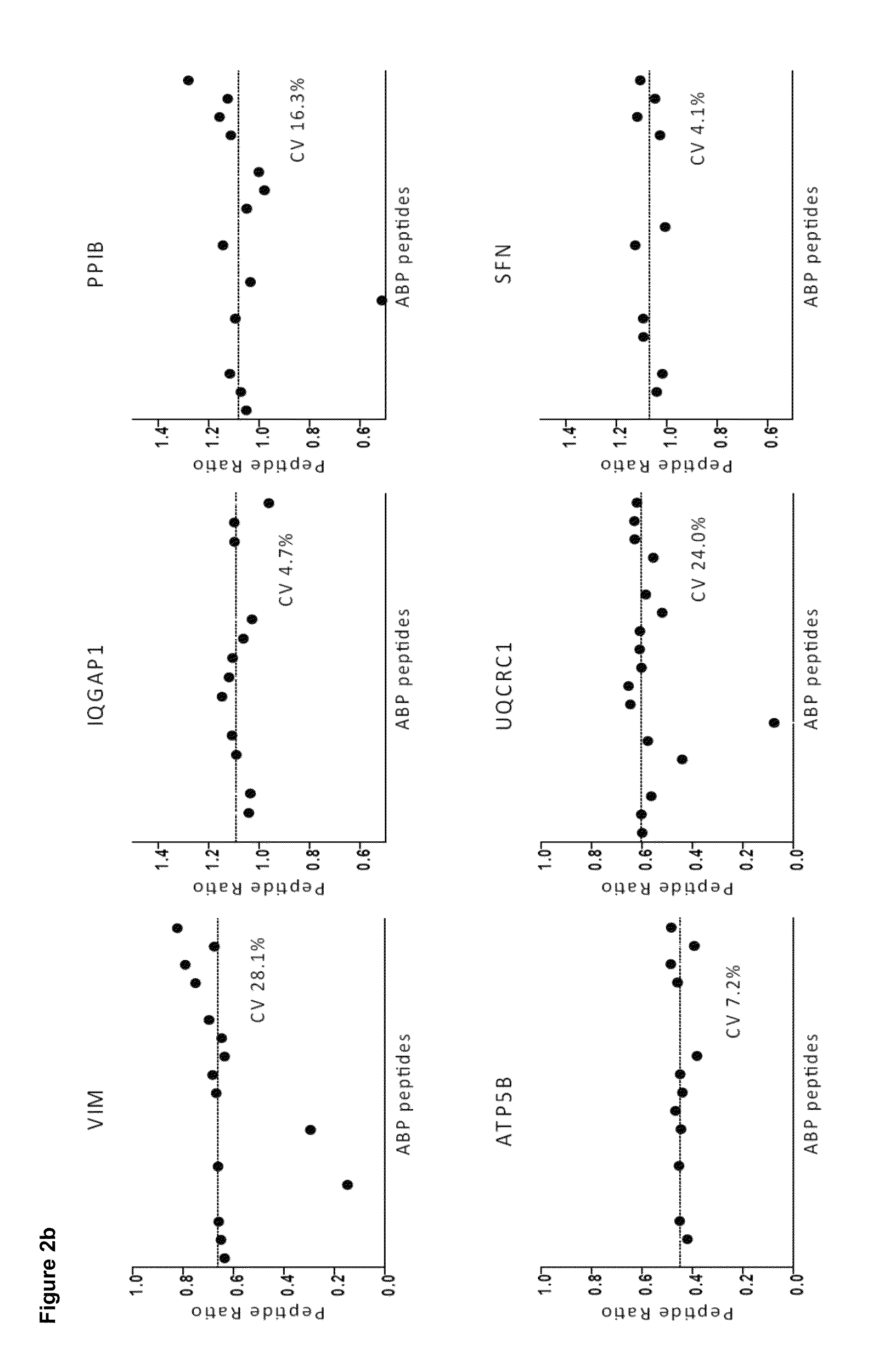Quantitative standard for mass spectrometry of proteins
a mass spectrometry and protein technology, applied in the field of quantitative standards for protein mass spectrometry, can solve the problems of aqua strategy suffering from quantification uncertainties, aqua peptides are commercially available but expensive, and cannot correct any bias arising from protein fractionation effect or digestion efficiency
- Summary
- Abstract
- Description
- Claims
- Application Information
AI Technical Summary
Benefits of technology
Problems solved by technology
Method used
Image
Examples
example 1
Materials and Methods
[0089]Protein Epitope Signature Tags—The short protein fragments, i.e. the subsequences of target polypeptides, were produced in high-throughput by the Human Protein Atlas where they are used as antigens for antibody production (18, 19). In brief, suitable Protein Epitope Signature Tags (PrESTs) representing unique regions of each target protein were designed using the human genome sequence as template (EnsEMBL). Unique PrESTs with a size between 50 to 150 amino acids and low homology to other human proteins were selected, including epitope- and domain-sized similarities to other proteins, signal peptides and transmembrane regions (18). The cloning, protein expression and purification were performed as previously described (19, 20). For optimal storage PrESTs were lyophilized and dissolved in 8M urea and stored at −20° C. until further use. To ascertain that the PrESTs had an endogenous counterpart in HeLa cells, we selected 50 proteins spread over the abundance...
example 2
Absolute Quantification of Proteins in HeLa Cells
[0100]Unlike relative quantification, absolute quantification may be effected as a two step process that firstly requires measurement of the absolute amount of the standard and secondly the relative amount of the standard compared to the analyte of interest. Determination and subsequent control of the level of standard is by no means trivial and can easily be the step that limits the overall accuracy of the approach. Below, we first describe a generic method to determine the absolute amount of each PrEST with high accu racy.
[0101]Then we construct a ‘master mix’ of different PrESTs and evaluate the ability of the SILAC-PrEST method to accurately quantify cellular proteins. We then apply the master mix to determine the copy numbers of 37 proteins in a cancer cell line. Finally, we describe an alternative workflow for the quantification of single proteins of interest, in which the two steps are combined into one LC MS / MS analysis.
[0102]...
example 3
Absolute Quantification Using Mouse PrESTs
[0127]Experimental procedure—The mouse PrESTs fused with a N-terminal His-tag were expressed in an auxotrophic E. coli strain using minimal media, supplemented with isotope labeled 13C6 15N2-Lysine (Lys8) and 13C615N4-Arginine (Arg10) (Cambridge Isotopes Laboratories) to obtain ‘heavy’ labeled proteins. The bacteria were harvested by centrifugation, lysed in 7M guanidinium chloride, 47 mM Na2HPO4, 2.65 mM NaH2PO4, 10 mM Tris HCL, 300 mM NaCl, 10 mM beta-mercaptoethanol, pH 8.0 and the His-fusion PrESTs were enriched on a Cobalt Talon column (Clontech) and eluted in 6 M Urea, 50 mM NaH2PO4, 100 mM NaCl, 30 mM Acetic acid, 70 mM Na-acetate pH 5 (29).
[0128]Blood samples were drawn from mice into tubes containing heparin. The blood was centrifuged twice at 70 g and each time the supernatant, the platelet rich plasma (PRP), was retained. Apyrase and prostacyclin (PGI2) were added to the PRP to inhibit platelet aggregation. The sample was centrifu...
PUM
| Property | Measurement | Unit |
|---|---|---|
| concentration | aaaaa | aaaaa |
| concentration | aaaaa | aaaaa |
| pH | aaaaa | aaaaa |
Abstract
Description
Claims
Application Information
 Login to View More
Login to View More - R&D
- Intellectual Property
- Life Sciences
- Materials
- Tech Scout
- Unparalleled Data Quality
- Higher Quality Content
- 60% Fewer Hallucinations
Browse by: Latest US Patents, China's latest patents, Technical Efficacy Thesaurus, Application Domain, Technology Topic, Popular Technical Reports.
© 2025 PatSnap. All rights reserved.Legal|Privacy policy|Modern Slavery Act Transparency Statement|Sitemap|About US| Contact US: help@patsnap.com



